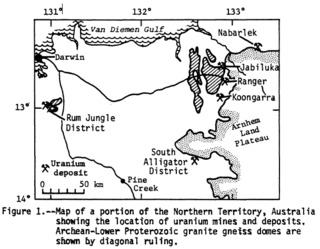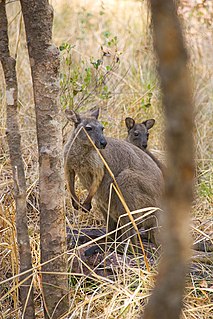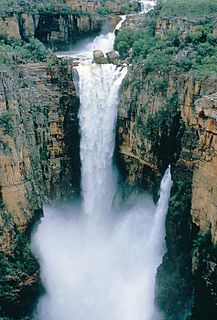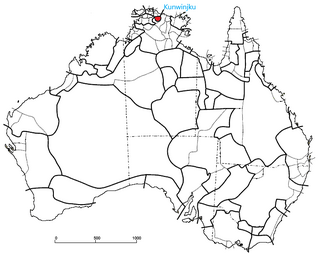Related Research Articles
In Australian Aboriginal mythology, Mamaragan or Namarrkon is a lightning Ancestral Being who speaks with thunder as his voice. He rides a storm-cloud and throws lightning bolts to humans and trees. He lives in a puddle.

The Warlpiri language is spoken by about 3,000 of the Warlpiri people in Australia's Northern Territory. It is one of the Ngarrkic languages of the large Pama–Nyungan family and is one of the largest Aboriginal languages in Australia in terms of number of speakers. One of the most well-known terms for The Dreaming, Jukurrpa, derives from Warlpiri.

Alligator Rivers is the name of an area in an Arnhem Land region of the Northern Territory of Australia, containing three rivers, the East, West, and South Alligator Rivers. It is regarded as one of the richest biological regions in Australia, with part of the region in the Kakadu National Park. It is an Important Bird Area (IBA), lying to the east of the Adelaide and Mary River Floodplains IBA. It also contains mineral deposits, especially uranium, and the Ranger Uranium Mine is located there. The area is also rich in Australian Aboriginal art, with 1500 sites. The Kakadu National Park is one of the few World Heritage sites on the list because of both its natural and human heritage values. They were explored by Lieutenant Phillip Parker King in 1820, who named them in the mistaken belief that the crocodiles in the estuaries were alligators.
Ngalakan (Ngalakgan) is an Australian Aboriginal language of the Ngalakgan people. It has not been fully acquired by children since the 1930s. It is one of the Northern Non-Pama–Nyungan languages formerly spoken in the Roper river region of the Northern Territory. It is most closely related to Rembarrnga.
Iwaidja, in phonemic spelling Iwaja, is an Australian aboriginal language of the Iwaidja people with about 123 native, with an extra 20 to 30 L2 speakers in northernmost Australia. Historically having come from the base of the Cobourg Peninsula, it is now spoken on Croker Island. It is still being learnt by children within the Northern Territory.

Gunbalanya is an Aboriginal Australian town in west Arnhem Land in the Northern Territory of Australia, about 300 kilometres (190 mi) east of Darwin. The main language spoken in the community is Kunwinjku. At the 2016 Australian census, Gunbalanya had a population of 1,116.
Nicholas "Nick" Evans is an Australian linguist and a leading expert on endangered languages. He was born in Los Angeles, USA.
Nunggubuyu or Wubuy is an Australian Aboriginal language, the traditional language of the Nunggubuyu people. It is the primary traditional language spoken in the community of Numbulwar in the Northern Territory. The language is classified as severely endangered by UNESCO, with only 272 speakers according to the 2016 census. Most children in Numbulwar can understand Nunggubuyu when spoken to, but cannot speak it themselves, having to reply in Kriol. To counter this, starting in 1990, the community has been embarking on a revitalisation programme for the language by bringing in elders to teach it to children at the local school.

The black wallaroo, also known as Woodward's wallaroo, is a species of macropod restricted to a small, mountainous area in Arnhem Land, Northern Territory, Australia, between South Alligator River and Nabarlek. It classified as near threatened, mostly due to its limited distribution. A large proportion of the range is protected by Kakadu National Park.

Wagiman, also spelt Wageman, Wakiman, Wogeman, and other variants, is a near-extinct Aboriginal Australian language spoken by a small number of Wagiman people in and around Pine Creek, in the Katherine Region of the Northern Territory.

The Jim Jim Falls is a plunge waterfall on the Jim Jim Creek that descends over the Arnhem Land escarpment within the UNESCO World Heritage–listed Kakadu National Park in the Northern Territory of Australia. The Jim Jim Falls area is registered on the Australian National Heritage List.
Dalabon is a Gunwinyguan language of Arnhem Land, Australia. It is a severely endangered language, with perhaps as few as three fluent speakers remaining as of 2018. Dalabon is also known as Dangbon, Ngalkbun, and Buwan.

The Gunwinggu (Kunwinjku) people are an Australian Aboriginal people, one of several groups within the Bininj people, who live around West Arnhem Land to the east of Darwin, Northern Territory. Kunwinjku people generally refer to themselves as "Bininj" in much the same way that Yolŋu people refer to themselves as "Yolŋu".
The Burarra language is an Australian Aboriginal language spoken by the Burarra people of Arnhem Land. It has several dialects.
Gunbarlang, or Kunbarlang, is an Australian Aboriginal language in northern Australia with multiple dialects. Other names are Gungalang and Warlang. Speakers are multilingual in Kunwinjku and Mawng. Most of the Gunbarlang people now speak Kunwinjku.
Rembarrnga (Rembarunga) is an Australian Aboriginal language. It is one of the Northern Non-Pama–Nyungan languages, spoken in the Roper River region of the Northern territory. There are three dialects of Rembarrnga, namely Galduyh, Gikkik and Mappurn. It is a highly endangered language, with very few remaining fluent speakers. It is very likely that the language is no longer being learned by children. Instead, the children of Rembarrnga speakers are now learning neighbouring languages such as Kriol in south central Arnhem Land, and Kunwinjku, a dialect of Bininj Gunwok, in north central Arnhem Land.
The Morrobolam language, formerly known as Morrobalama and Umbuygamu, is a possibly extinct Paman language from Princess Charlotte Bay in far-north Queensland in Australia which was spoken by a group the Lamalama people.

The Macro-Gunwinyguan languages, also called Arnhem or Gunwinyguan, are a family of Australian Aboriginal languages spoken across eastern Arnhem Land in northern Australia. Their relationship has been demonstrated through shared morphology in their verbal inflections.
The Bininj are an Aboriginal Australian people of Western Arnhem land in the Northern Territory. The sub-groups of Bininj are sometimes referred to by the various language dialects spoken in the region, that is, the group of dialects known as Bininj Gun-Wok; so the people may be named Gunwinggu, the Kuninjku, Kundjeyhmi (Gundjeihmi), Manyallaluk Mayali, Kundedjnjenghmi and Kune groups.
The Dalabon or Dangbon are an Australian Aboriginal people of the Northern Territory.
References
- ↑ "North-West Arnhem: 2016 Quick-Stats". Australian Bureau of Statistics. Retrieved 27 October 2017.
- ↑ N186 Bininj Gun-wok at the Australian Indigenous Languages Database, Australian Institute of Aboriginal and Torres Strait Islander Studies
- 1 2 "Orthography— how to write words". Bininj Gunwok. Kunwinjku Language Project. Retrieved 1 October 2015.
- ↑ Evans 2003
- ↑ "N186: BININJ GUN-WOK / BININJ KUNWOK". AIATSIS Collection: AUSTLANG. 26 July 2019. Retrieved 19 February 2020.
- ↑ "Language". Parks Australia. Retrieved 19 February 2020.
- ↑ "Language". parksaustralia.gov.au. Retrieved 21 January 2022.
- ↑ Evans 2003 , chapter 2
- ↑ Evans 2003 , chapter 6